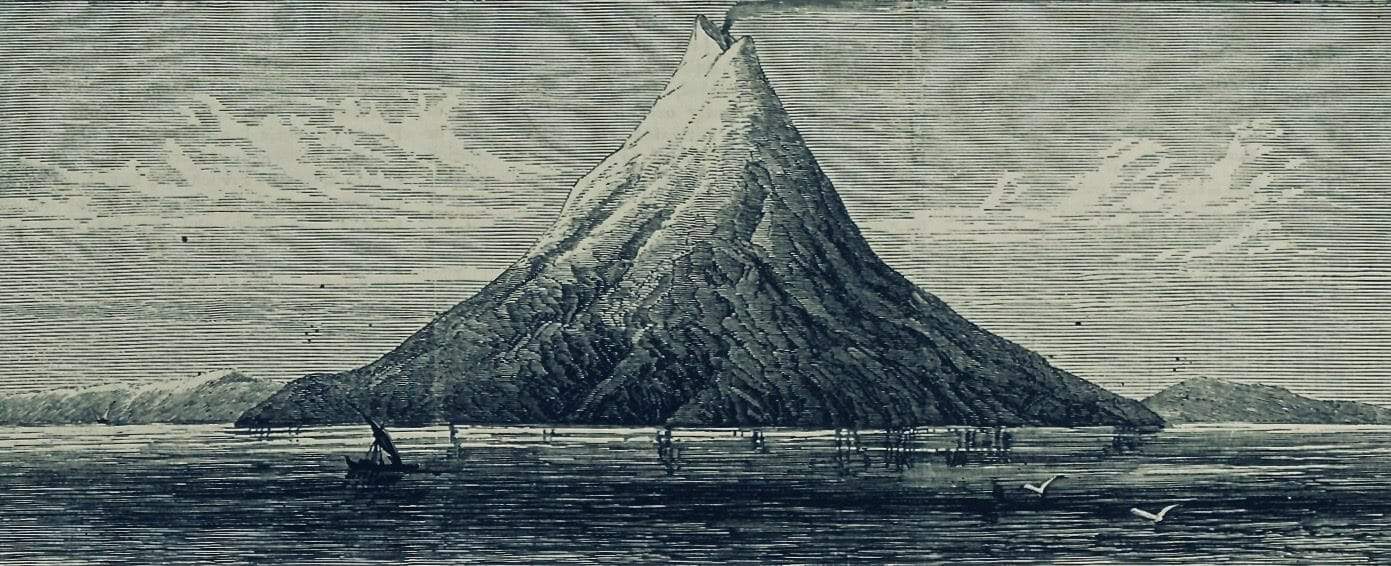│By Amelie Bonney, Gale Ambassador at the University of Oxford│
On December 9, 2019, the deadly volcanic eruption of Mount Whakaari in New Zealand sparked new discussions over risk assessment in volcanic regions. While sudden volcanic eruptions make it difficult for scientists to assess risks in such areas, the belief that eruptions can be predicted thanks to science also leads to increasingly hazardous activities such as tourism in dangerous volcanic regions. How and why have humans become so intrepid when it comes to volcanoes?
The Gale Primary Sources archives provide not only newspaper articles but also a range of valuable monographs and visual sources, ranging from drawings to photographs, which allow us to investigate how our understanding and perception of volcanic eruptions has changed over the last few centuries. The sources demonstrate that the scientific community’s investigations led to the emergence of new understandings of dangerous volcanic eruptions from the late eighteenth century onwards. Paradoxically, scientific explanations of volcanic eruptions created a heightened sense of danger but also led to an increase in risk-taking behaviour.
Understanding Volcanoes
Gale’s Eighteenth Century Collections Online archive reveals that in the late eighteenth century many naturalists and philosophers started to question the Christian belief that the Earth had remained unaltered since God’s creation. The Earth, they argued, had been gradually changing over a long period of time. This new theory radically questioned previous conceptions of volcanic eruptions as a punctual, determined event that was a sign of God’s wrath.
With the emergence of geology as a new field of scientific investigation, the study of volcanoes became central to understanding the age of the Earth and the different stages of its geological past. While volcanic eruptions had long been considered as exceptional accidents, in the early nineteenth century, they became seen as an ordinary process affecting the planet, in the wake of writings such as George Lyell’s Principles of Geology (1830). He challenged the widely shared belief that the earth was initially a ball of fire which was undergoing a cooling process, and developed a theory known as gradualism.

These ideas were also embraced by contemporaries such as biologist and naturalist Jacques-Julien Labillardière, who observed the formation of new volcanoes during his explorations.
![Primary Source
Labillardière, Jacques-Julien. An account of a voyage in search of La Pérouse, undertaken by order of the Constituent Assembly of France, and performed in the years 1791, 1792, and 1793, … Vol. 1, printed for J. Debrett, Piccadilly. [by S. Gosnell], 1800. Eighteenth Century Collections Online](https://review.gale.com/wp-content/uploads/2020/02/3-New-Volcano.jpg)
In addition to these observations, Labillardière and his companions also started measuring the temperature of volcanoes as they climbed them, noting for example that some of the hot vapour produced by the volcano “causes Reaumur’s thermometer to rise to 67° above 0, producing a noise somewhat similar to the buzzing of bees”.
Scientific discussions of volcanoes also extended to the moon and even other planets. In 1787, William Herschel observed what he believed to be volcanoes on the moon, and reported that he perceived “three volcanos in different places of the dark part of the new moon”. Discussions such as these ones popularised the notion that volcanoes and volcanic eruptions were the outcome of long-term geological processes which affected the whole solar system. This opened the way for new conceptions of the risks and ways to assess them, as volcanic eruptions gradually ceased to be interpreted as the sign of God’s wrath and were approached in more scientific terms, which implied that they could be measured, and possibly predicted.
The existence of volcanoes and of their function, however, remained a topic of debate. Different theories on volcanoes coexisted, challenging those of geologists. English mathematician and surveyor Charles Hutton reported that Thomas Crosby considered volcanoes as a means of canalising electric fluids contained in the earth.
![A close up of text on a white background. Primary Source
Hutton, Charles. The diary companion; being a supplement to The ladies’ diary, for the year 1795. Containing answers to the last year’s enigmas, rebuses, charades, Queries, and Questions; both in the Diary and Supplement. … By the Diary author. Printed for G. G. and J. Robinson, Paternoster-Row,[1795]. Eighteenth Century Collections Online.](https://review.gale.com/wp-content/uploads/2020/02/4-Electric-Volcano-1024x293.jpg)
Others, such as Jacobus of Norwich,saw them as “a sort of funnel or vent to disgorge the fire and vapour contained in the bowels of the earth”. These examples demonstrate that eighteenth-century observers of volcanoes defended various theories which were shaped by their individual background and interests. They provided a range of interpretations of volcanic phenomena which were far from the more standardised study of volcanoes which would develop in the late nineteenth century.
The Eruption of Krakatoa in 1883
In 1883, one of the most spectacular volcanic eruptions of the nineteenth century occurred in Indonesia. Mount Krakatoa, which is located in the Sunda Strait between the islands of Java and Sumatra, devastated the population and the landscape of a vast portion of this region. By this time, scientists used a range of tools to measure the intensity of eruptions, such as barometers.

While such tools made it possible to register the intensity of the eruption in numbers, and therefore to classify it according to a scale, newspapers still used first-hand accounts of such disasters to provide their readers with vivid descriptions. Such accounts gave a more detailed description of the different stages of the eruption, and of the hazards they entailed, as for example the “falling lava” mentioned by one survivor in the following article from the British Library Newspapers:
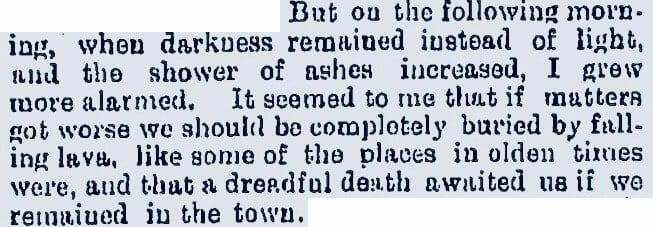
The source below from Nineteenth Century U.S. Newspapers shows that the eruption was discussed around the world, prompting a response in the United States, where the Rocky Mountain News opted for a series of short and sensational titles to emphasise the horrendous effects of this natural disaster.
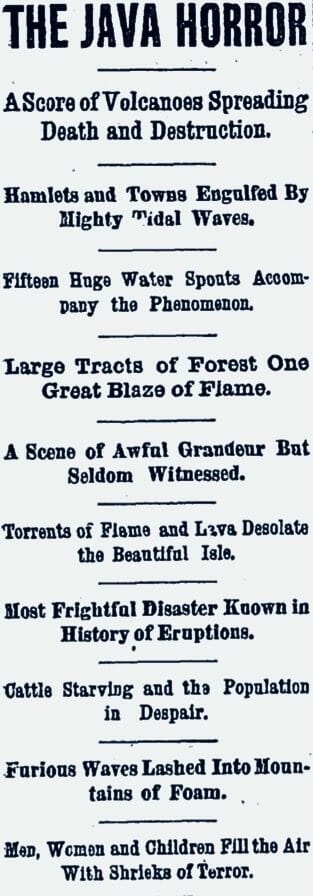
While the 1883 Krakatoa eruption was described in vivid and sensational terms by newspapers, visual depictions of volcanic eruptions in the late nineteenth century were not as dramatic as those we see today, partly due to the use of drawings rather than photographs. Images also tended to depict the landscape in which volcanoes were situated, and they often seem strangely peaceful. This does not mean that volcanic eruptions were perceived as harmless. Rather, imagery was used in a different way, focusing more on the risks they entailed. For example, depictions of the 1883 eruption of Krakatoa represent not only the volcano itself, but also the villages and locations destroyed by the eruption, to help readers visualise the extent of the disaster.
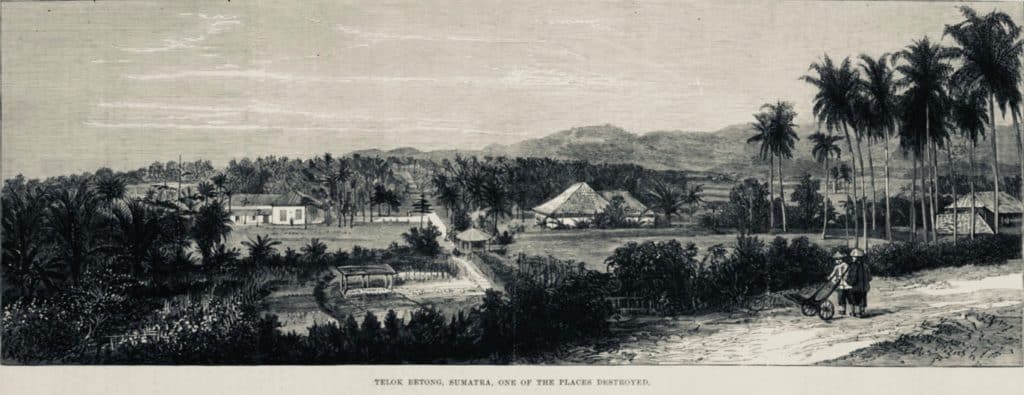
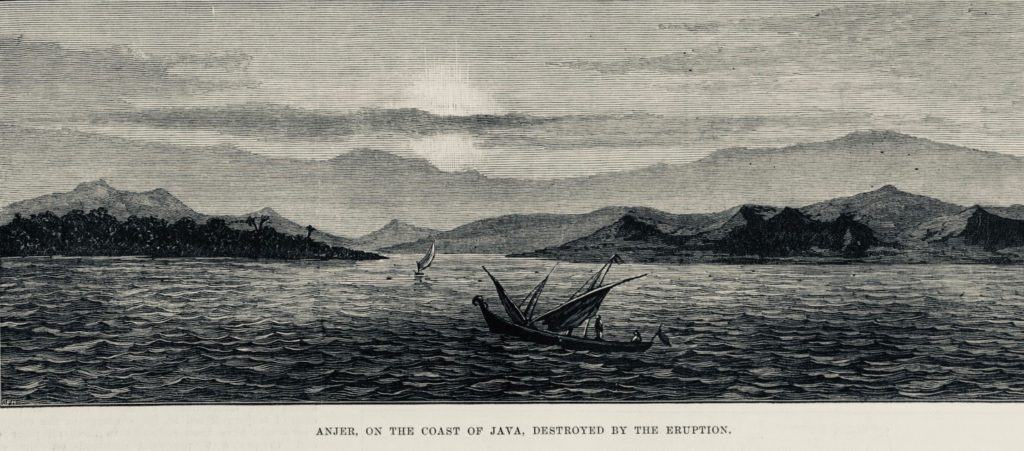
Such depictions could also be used to support viewpoints and narratives which emphasised how dangerous colonial spaces could be, as a means to legitimise Western intervention; if colonisers could use Western science to predict hazards and control this seemingly untameable nature, then Western presence in these areas could be more easily justified. Volcanic eruptions like that of Krakatoa caused tensions between European settlers and the native populations. This is evident in the excerpt below, which relates to the Dutch occupation of Java.

As this excerpt demonstrates, native populations in Java interpreted the eruption of Krakatoa as a sign of their deities’ wrath, and blamed European policies for the disaster. The eruption thus had deeper political implications, in addition to the environmental ones. Visual elements such as drawings became an increasingly powerful tool for newspapers, who were influential in shaping national perceptions of natural disasters and their political, environmental and economic consequences.
Visualising the Hazards of Volcanic Eruptions in the Twentieth Century
For most of the nineteenth century, volcanoes and volcanic eruptions were portrayed in the press via drawings based on accounts and sketches of local observers, such as those above of Krakatoa and the following ones, from 1860 and 1890.

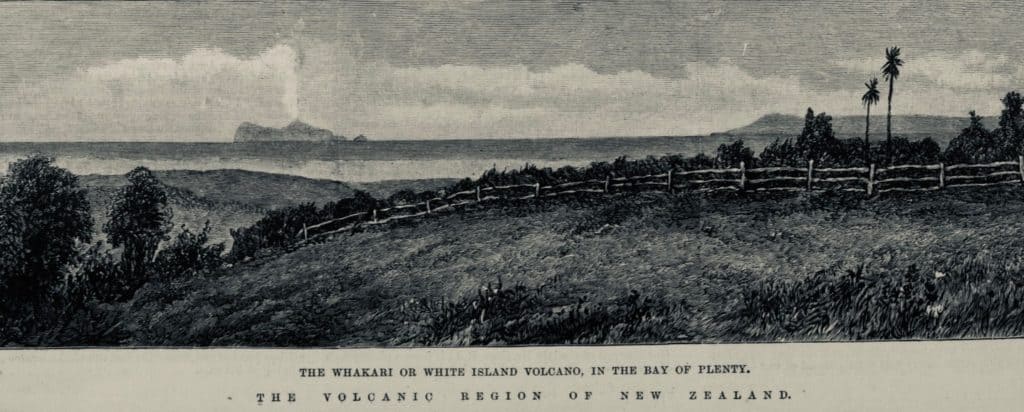
In 1881, John Wesley Judd first published a woodcut of a photograph of the 1872 volcanic eruption of Mount Vesuvius. From then on, photographs of spectacular eruptions gradually made their way into the press, altering the ways in which these accidents were perceived. Obtaining the very first photographs of volcanoes was extremely difficult, however, as described by this photographer in the Illustrated London News Historical Archive:
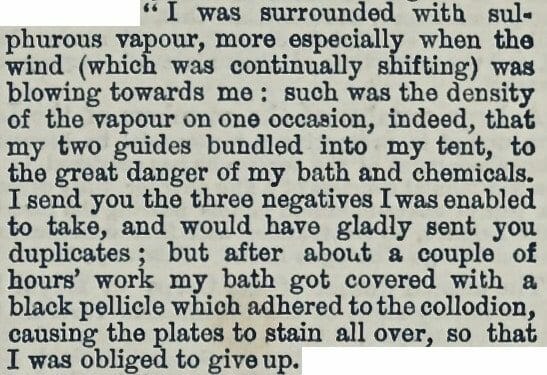
Over time, photographs were used increasingly often to spread knowledge about volcanoes. In 1907, W. Herbert Garrison, who was an experienced explorer of volcanoes in all parts of the world, gave a lecture at the London Institution in which he described particular volcanoes, using photographs as part of his demonstration. However, his statement reveals that photos were often used in a similar way to the drawings previously seen in the Illustrated London News –to show places since destroyed by eruptions, rather than the eruption itself.

By 1928, photographs could be used to document the eruption of submarine volcanoes near Krakatoa. An entire series of photographs like the one below was published by the Illustrated London News.
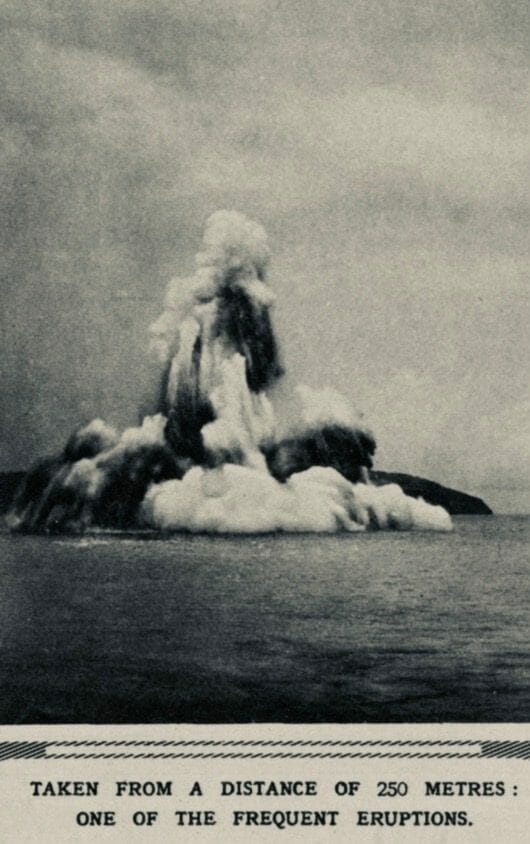
More recent articles such as that below, accessible via the Times Digital Archive, show how the portrayal of volcanic eruptions has changed over time. When Mount St Helens erupted in the United States in 1980, killing 57 people and leading to large-scale economic disturbances, the eruption was also portrayed in highly dramatic terms by the press, using photographs of the disaster to enhance their narrative. The use of these photographs made the coverage more sensational and graphic, but articles, such as that below from the Times Digital Archive, also continued to rely on the first-hand accounts of survivors.
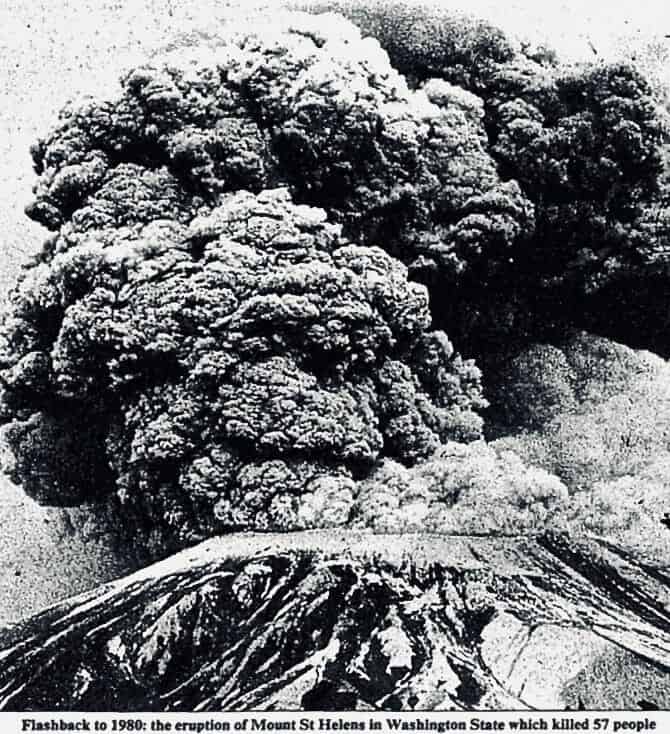
The use of photography had differing, paradoxical effects: whilst on one hand photographs accurately portrayed the violence of volcanic eruptions, on the other they gave the viewer a sense of control over these phenomena, seemingly minimising the risks. With photographers appearing to be able to journey into the heart of the eruption and volcanoes started to appear less hazardous, it incentivised tourists to visit these sites for recreation. This fascination with volcanic eruptions was not new, though, as the following letter from 1867 demonstrates. Risky behaviour for the sake of entertainment is far from a novelty of the twentieth century.

While the hazards of volcanic eruptions were known long before the eighteenth century, many conflicting theories emerged at that time, with the advent of new scientific methods, to explain them. Methods to assess the risks have improved over the past two centuries, notably due to the use of new measuring methods and new technology (such as photography) allowing a more accurate visualisation of these phenomena. Volcanic eruptions remain difficult to predict, however, and seem to be on the rise, prompting numerous debates on the limits of scientific knowledge and on the role of climate change in prompting volcanic activity.
If you wish to learn more about the history of volcanoes, geology, or risk, or if you need advice on the best ways to use Gale Primary Sources for your own research, feel free to contact me via Twitter (@BonneyAmelie).
Want to read more about how the Krakatoa volcanic eruption is presented in the archives? Check out this post by Gale’s Associate Acquisitions Editor which explains why it was the first global media event. Grace Mitchell-Kilpatrick has also explored Attitudes Towards Climate Change in Gale Primary Sources.
Blog post cover image citation: “The Straits of Sunda: Terrible Volcanic Eruption.” Illustrated London News, 8 Sept. 1883, p. 229. The Illustrated London News Historical Archive, 1842-2003. https://link.gale.com/apps/doc/HN3100116793/GDCS?u=oxford&sid=GDCS&xid=9e305b33

